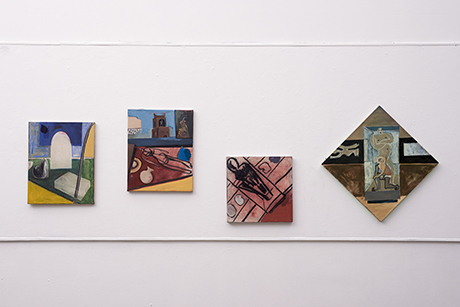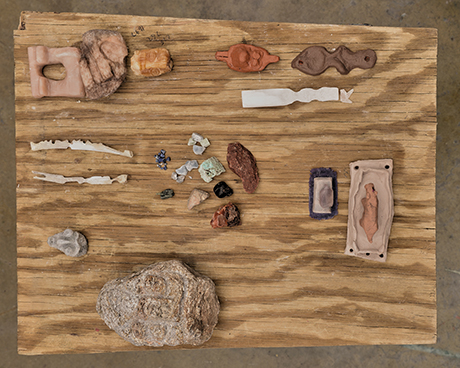March 28 - 31, 2018
Opening Reception: March 30, 6-8pm

Canaan and Ancient Israel
Charcoal, chalk, acrylic and oil colors on canvas and linen.

Imitation and Emulation, 2017
Stones and gems, clay, painting mediums and bone.
Artist Statement
Many orthodox people speak as though it were the business of skeptics to disprove received dogmas rather than of dogmatists to prove them. This is, of course, a mistake. If I were to suggest that between the Earth and Mars there is a china teapot revolving about the sun in an elliptical orbit, nobody would be able to disprove my assertion provided I were careful to add that the teapot is too small to be revealed even by our most powerful telescopes. But if I were to go on to say that, since my assertion cannot be disproved, it is intolerable presumption on the part of human reason to doubt it, I should rightly be thought to be talking nonsense. If, however, the existence of such a teapot were affirmed in ancient books, taught as the sacred truth every Sunday, and instilled into the minds of children at school, hesitation to believe in its existence would become a mark of eccentricity and entitle the doubter to the attentions of the psychiatrist in an enlightened age or of the Inquisitor in an earlier time.
— Bertrand Russell 1952
My ideas did not really change much during my adult life. Focusing on research and thinking that I have undertaken after first reading these British philosopher's words over a decade ago. Originally, Russel's allegoric notion of the teapot was created to disprove the claim that in a matter of religious faith over an unprovable issue, the burden of proof rests with the skeptic, who must prove that the faith is wrong. For me, the analogy was that and more; I thought increasingly about the authority of antiquity and the narrative of religion or archeology--or even the authority of information, morality and history.
My initial interest in art and religion originated during my childhood in Jerusalem. My grandmother exposed me to art and ancient mythologies through books and sites or museum visits. I was attracted to symbolic fantasy and visual religious ideas. However, I became more aware of the internal conflicts it presented with my surroundings – specifically, the religious set of laws or agendas and any claims of holly places and absolute truths, common claims in Jerusalem, which spiritually and spatially divide the city very clearly. These questions have escorted me all my life; what is right? Who is right?
In this space, I became more and more troubled, yet also fascinated by what I believed were the theological mechanisms that created the reality I observed. I pursued these interests first as a student of Archaeology and Religious Philosophy at Tel-Aviv University. There, I learned to appreciate the importance of art in the history of rendering theological meta-narratives or fictional cultural icons. This understanding, coupled with my desire to reenact mythology, is what made me decide to concentrate on painting. As an undergraduate, and now as a graduate student at Tyler, I have continued exploring allegories and fantasy through my theoretical research and studio work. The way imagination is visually represented and its status as an allegoric implement was and still is an essential element of my practice.
The art that I make is about the present or contemporary perception of the past and future; How do we think and imagine the past and future? How will we look to the future as past? I ask that by trying to create symbolic systems; with "trying" being the main action in this prosses, or the prosses itself being my research subject. The prosses of creating a system of symbols, such as alpha-bet, a pantheon or traffic-signs. What is an architype? which icon is necessary or impotent enough to "make it" or to be "left out". These are the questions I ask myself when making. That Idea came clearer when I moved to the USA, to the "new world" and met the American attitude toward antiquity. A place that replaced and erased the Past of the land by the new ideas and culture (something that the Israelis are still trying to do and finding to be impossible to some measure), by new monuments that remind in their style and approach a different past, the one of "The mother land" or the "old world". This "lack" of antiquity and ancient past pushed the people of this great land to create a simulation of all that is missing. Just as Baudrillard wrote in his "Simulacra and Simulation"; A copy of a missing thing, or the opposite of camouflage (that hide what is there). A situation in which you present something that isn't there like it is (because it isn't).
At the Penn Archeological museum, I started noticing the structure of the museum's galleries, the curation, the exhibition of artifacts and factual information followed by "suggestive" information that is closer to interpretation. While visiting the museum, I was also paying more and more attention to the artifacts themselves, including the crafting techniques and the attributes and symbolism of the objects. I decided to start sculpting myself, first with clay and oil-based clay and later wood and stone. Sculpture affected my painting and drawing at once. I began to develop a personal symbolic language, a kind of "Semitic abstraction" based on the abstraction that the alpha-bait has passed from Egyptian hieroglyphics to Sinai and spread through the middle east and Europe up to the letters I'm using right now to write. My drawings began to be influenced from this evolutionary process, dealing less with subjective individuals and more with symbol/letter-like figures, ones that function more as general ideas, words, or expressions, prototypes of characters.